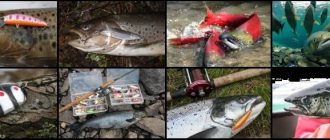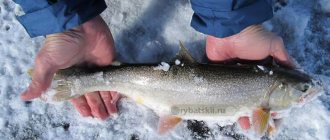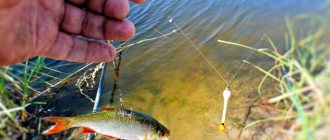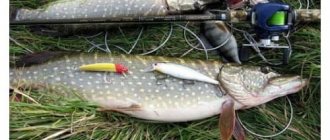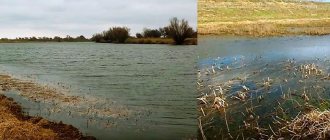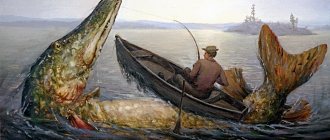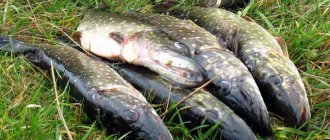Pike – a predatory fish, the most treasured trophy among fishermen. Some specimens weigh about 20 kg. In special cases, you can find pike more than 1.5 meters long. In addition, as a rule, females are larger than males. In the fishing circle, it is customary to call a pike weighing more than 10 kg “crocodile”.
In order for fishing to bring not only pleasure, but also to please you with a good catch, you should know all the intricacies of preparation and the fishing process itself.
In this section we will analyze all the methods of fishing for pike, as well as how to properly catch pike at this or that time of the year.
Pike lifestyle and habitats
Predatory fish are conventionally divided into two types - “ambushers” (those that attack their prey from cover) and “catchers” (predators that directly pursue their prey). Pike belongs to the first option. Compared to other types of fish, it has its own characteristics. Where should you fish for pike? Here are the basic principles of searching for it in a body of water:
- The predator lives in places overgrown with grass. Most often it sticks to the shore and stagnates in the roots of trees. Larger pike live at depth in the steeps and hunt only in the early morning or late evening.
- Pike has the ability to change its color. That is why in different bodies of water and places you can find both light golden and dark brown predators.
- The main feature of pike is its eyes. They protrude from the head. Thanks to this, the predator has a large overview of the area, even when standing in one place.
Predator food
Pike eats almost everything that comes its way, mainly of animal origin. Its victims may be:
- juveniles and adult fish;
- worms, beetles, larvae, leeches (especially after spawning);
- rodents that swim across a body of water;
- small waterfowl.
Biting periods
There are three main periods of active pike biting:
- Pre-spawning period.
- Post-spawning period (1-2 weeks after spawning).
- Autumn bite before wintering.
In summer, the predator is inactive. This especially depends on weather conditions. The bite intensifies during a thunderstorm and at low atmospheric pressure (indicators of 145 and below).
Spawning
The timing of pike spawning depends on the temperature of the water. The thermometer readings should be no less than + 3 degrees Celsius. As a rule, this falls in the first ten days of March. Pike begin to spawn only at the age of three. The female lays her eggs on fallen branches or coastal vegetation. The number of eggs depends on age.
Open water fishing methods
From early spring to late autumn, there are four ways to catch pike in open water, namely:
- fishing for pike with a spinning rod;
- catching pike on the track (trolling);
- fishing for pike with mugs;
- catching pike with a rig.
- Spinning fishing.
The most common way to catch pike is spinning fishing. But the choice of gear should be taken seriously. There are several important points to consider:
- When choosing a spinning rod, you need to pay attention to its structure. You need to raise the rod so that the top rests against the wall and gently press the handle. A good fishing rod should bend evenly in accordance with its action.
- The reel must be inertia-free, so that when casting, “beards” do not appear and the line does not get tangled. This reel allows for longer casting. All types and designs of spinning rods are suitable for pike fishing, since the predator responds well to baits of different weights from 2 to 150 g.
- You should choose a spinning rod based on the desired size of the fish, the weight of the bait and the fishing method.
In the next video you can see how to catch pike with a spinning rod . Quite interesting and useful material, we recommend it.
Catching pike with a fishing rod
A float rod is also used to catch pike. It is equipped with a sliding large float, and live bait is attached to the hook. The fisherman makes a cast and waits for the pike to grab the bait. Practice has established that hooking should not be done immediately in order to give the predator time to swallow the fish. The structure of a float rod is the same as that of a spinning rod, but its length can be much longer.
If almost anyone knows what a spinning rod and a fishing rod are, even those not related to fishing, then not everyone knows what a girder is, despite the fact that girders have been used for catching pikes at least since the 18th century. The most famous zherlitsa is the slingshot. Its appearance and manufacturing methods for pike fishing have remained unchanged for two centuries. In the forest, something like a slingshot is cut out of branches and planed, giving the future fishing tackle a cultural appearance. Then ten meters of fishing line or nylon thread are wound crosswise around the slingshot. At one of the two ends of the slingshot, a split is made into which the free end of the scaffold is inserted. A hook is tied to the line, and a sinker is placed above it. The zherlitsa is tied either to a bush hanging over the water, or to a pole, which is driven into the desired place. A live fish is attached to the hook. When a predator grabs the bait, the line will jump out of the split and unwind; the unwinding will end - the pike will be hooked.
Catching pike on a float: equipment, tackle video
What to cook from pike:
- How to dry pike at home;
- Homemade marinated pike
Lures
There is a large selection of baits. Sometimes it's hard to settle on anything specific. After all, each bait has its own characteristics. Usually pike are caught using baits such as:
Spoon has a very large variety of flowers. Its use depends on the transparency of the water. The more transparent the pond, the darker the spoon should be. You should not give preference to tees of impressive size. Because in this case, the fish may sense a catch.- The wobbler is selected according to the same principle as the spinner. But it is better to give preference to natural and acidic colors.
- Twisters and vibrotails (jigs) create a visual illusion for pike. The predator recognizes them as worms or larvae. The tail moves in waves and imitates a living organism. Jig is most suitable for deep waters and places where there are a lot of snags, algae and stones.
- Popper (a squelching type of wobbler) is a bait that mainly attracts pike in the summer and early autumn.
- Fishing with live bait . The best options for pike are perch, roach, crucian carp, silver bream, bleak, gudgeon, and rudd. The larger the size of the bait or live bait, the greater the chance of catching a big pike. A small fish is more likely to bite on a small bait.
More information about pike lures and their choice can be found in the article “Lures for catching pike with a spinning rod,” which also tells you when you can catch pike and with what lures.
The choice of bait depends not only on the terrain, but also on weather conditions and the fishing season.
Fishing line. When choosing a fishing line or braided cord, you should give preference to the following diameters:
- fishing line 0.3-0.5 mm;
- cord 0.1-0.2 mm.
A fishing line of this diameter can easily withstand large specimens of pike. Please note that the reserve on the reel must be no less than 100 m.
If you use a thicker fishing line, the tackle loses its catchability. And besides, the bait worsens its playing qualities. But it is still better to give preference to a braided cord. Since it has minimal stretch, it is more wear-resistant and allows you to clearly control the bite and bait tactilely.
Wiring. Which one to choose? A very important point when fishing for pike with a spinning rod is correct wiring. It depends on the bait, the fishing location and the depth of the reservoir.
- Uniform wiring . When wiring this way, you need to rotate the coil evenly. The best baits are spinners: spinners and spoons.
- Uniform wiring with pauses - uniform rotation of the coil with stops.
- Stepped wiring . This type of wiring allows you to tap the bottom with bait. You need to cast and position the tip of the rod above you to create an angle between the direction of the line and the spinning rod. As soon as the bait touches the bottom, the rod tip will weaken. This means you need to start rewinding. Next, the coil needs to make 2-3 turns and stop. As soon as the bait reaches the bottom again, you need to reel again. This type of wiring is suitable for jig baits: twisters, vibrotails, various worms, crustaceans and similar silicone baits, which are loaded with a lead or tungsten weight.
- Twitching (jerk) wiring . This type of wiring is most often used when fishing with a wobbler. During the jerk, it moves to the side or makes a high-frequency oscillation. This game teases the fish and provokes action. The frequency of jerks, amplitude and pauses between twitches are selected based on the activity of the pike and the depth of the reservoir (if it is a sinking wobbler). As a rule, they do a jerk - a pause, two jerks - a pause, alternating them alternately.
Fishing with mugs
You can catch pike with mugs both from the shore and while sitting in a boat. The installation of gear and the technique of such fishing is very simple. Let's look at the features of this method.
- A fishing line is wound around a plastic or foam circle, which can be purchased at a fishing store. The length of the fishing line or cord depends on the depth of the reservoir. If the selected place has a depth of 5 meters, then the amount of fishing line should be three times larger, that is, 15 m.
- After the line is wound, you need to attach a sinker and a pike leash 20 cm long.
- The circles on the water are arranged in a checkerboard pattern. For successful fishing, the number of circles must be no less than 10 pieces.
- The main bait is live bait.
Trolling
Trolling is a method of catching pike in a pond that uses a boat with a motor. The bait is carried through the water not by reeling in the fishing line, but rather by the movement of the vessel. Most often they are caught by trolling in the fall - in October and September.
But for this type of fishing, certain equipment is required, namely:
- rigid rod up to 2.5 m long with a large handle;
- fishing line or braided cord with a diameter of 0.4-0.5 mm;
- multiplier reel;
- baits – wobblers and spinners;
- landing net or hook for removing fish;
- extractor and yawner;
- kukan;
- echo sounder to find out information about the day;
- boat.
The ideal place for catching pike by trolling is the edge, which is located in the places where the river turns.
To catch a predator, you need to lower the bait at a distance of 0.5 m from the bottom. If there are too many snags and stones in the area, the bait is raised higher. When you reach, by reeling, a hole at the bottom, it is better to stop so that the wobbler or spoon sinks to the bottom. Pike react sharply to noise. Therefore, it is worth swimming slowly. As a rule, the predator hides in algae and backwaters.
Pike fishing in winter
In winter, there are three periods for pike fishing:
- on the first ice;
- wilderness;
- fishing on the last ice.
The first period is characterized by the fact that the ice is still quite transparent and the pike can easily see a foreign object. To darken the ice, just pour water near the hole.
During the dry winter period, the pike goes to the bottom. Therefore, you will have to make at least 10 holes to find its habitat. Fishing for pike on the last ice will be the most productive, as the fish gains weight and reacts to almost any bait.
To catch pike, a larger hole is drilled so as not to have problems when lifting the catch from underwater.
In winter, a representative of the predatory family is caught in the following ways:
- To the girder;
- For live bait;
- On the balancers;
- For spinners.
Choosing a fishing spot
At the beginning of winter, when the process of water freezing has just begun, pike do not change their habitats. As a rule, it is located along the shore, in creeks. The best place for it is the edges with a sharp temperature difference.
During the dry winter period, pike sink to the bottom. It is also worth paying attention to tributaries and streams. The predator goes there for the fry.
When the ice begins to melt a little, pike can be caught in ice gaps - streams and creeks.
How to fish with a zherlitsa
Most often, in winter, pike are caught using a girder. You can make such gear yourself. It consists of the following parts:
- Pole;
- Equipment;
- Bite alarm;
- Reel with fishing line.
The stand itself should look like the letter “y”. Its length on average is 1 m. The turn in the letter itself should be about 60 degrees. The vent should be smooth so that there are no fishing line snags. The coil must be placed on the pin without play. The dimensions of the reel should not exceed the following parameters: diameter no less than 4-5 cm, width of the sides about 2 cm. If the parameters are different, the fishing line will slip and fall off. It is advisable to use an inertia-free coil.
A 0.5-1 mm fishing line is ideal, to which a 25 cm leash is attached. It is advisable that the leash be metal, otherwise the pike will bite it. As for the hook, markings 7-20 are quite suitable.
In order to have a good catch, you need to use at least 10 poles.
How to catch pike with live bait
In winter, the predator is best caught using live bait. It is advisable that it be from the same body of water as the pike. You can store it in a plastic container, where you constantly need to change the ice.
The choice of live bait depends on weather conditions and the fishing period. As soon as the first ice appears, the pike bites on small specimens of crucian carp. To enhance the bite, it is recommended to use roach or perch as live bait. But most of all, pike loves small minnows.
There are two ways to hang live bait on a hook:
- behind the back;
- by the upper lip.
You can learn more about fishing with live bait in the following video.
Fishing with spinners and balancers
In winter, pike fishing using balance beams and spoons is very popular. It is better to do this on the first ice, when the habitat of the predator is still visible.
To make your catch very satisfying, you need to know a few tips:
- During the period of first ice, the balance beams should not be more than 15 cm.
- The greater the depth of the reservoir, the more the balancer should hang.
- The main tactic for catching pike with a balance beam is to constantly search for fish throughout the entire body of water.
- The technique of fishing with a balance beam is quite simple. You need to lower the spoon to the bottom, and then raise it 15 centimeters and fix the rod. Next, you need to make a sharp wave of your hand with an amplitude of about 20 cm and fix the bait. It is at this moment that she makes characteristic movements, imitating a fish. As soon as the spinner stops, you should jerk again. This wiring is considered classic for a balancer.
- Closer to spring, the bait should decrease in size, but not less than 7 cm.
NETOBSERVER.RU
Pike fishing is one of the most exciting types of fishing, giving a surge of adrenaline and a storm of emotions from fighting a toothy freshwater predator. This process requires skills, dexterity and knowledge about your potential prey. Videos help you find out how a pike attacks, see its behavior live, and understand what ultimately attracts the predator. There are a lot of videos on YouTube - both just a pike attack, filmed by ordinary fishermen from a boat or from the shore, and underwater footage of a pike attack on a live bait or wobbler. It is very exciting to watch what is happening, both out of simple interest and by making certain “notes” for yourself in terms of how best to imitate the natural behavior of a pike “victim”. So, let's start watching.
The first video is carefully compiled from 5 different moments of a pike attack. Moreover, these are not episodes of fishing, but unique moments of hunting of a toothy predator in natural conditions. The quality of the image is reminiscent of the good old VHS days, but this does not diminish the entertainment value.
The next video shows us the behavior of a pike that was “presented” with an imitation of a slowly swimming wounded fish. We can observe how a predator studies its potential prey, and not from one angle, but from several at once. This underwater video will end with a lightning-fast attack of pike on such a unique “live bait”.
Video No. 3 from the same channel “Underworld Ireland”. In it we will learn how pike behaves during more active fishing, as well as what color (and shape) of the bait it prefers. Here underwater life is more active (even though the region is the same - Ireland), so it will be spectacular:
And here’s how pike attacks in a body of water with a current. Either running water motivates the fish to take more active action, or the predator really liked the bait used. One way or another, in this underwater shooting the number of pike attacks is noticeably higher. Unique shots are obtained by combining underwater photography and video from the water's edge - this is what happens when you hear a loud splash, and then only have time to see powerful circles spreading out on the water surface:
No. 5 – another compilation of some episodes. Here you can see underwater photography, a pike attacking ducklings at the surface of the water, and an attack on a cat, which was already present in this review. But some replays are worth going through for unique shots: have you seen how a pike swallows a fellow almost the same size as itself? What about pike in the aquarium? Would you like to have a similar “pet” for yourself?
Video No. 6 simulates a rather unusual situation. You already have a good idea of the behavior of pike when guiding a wobbler/vibrotail or live bait - i.e. reaction to bait in motion. What if the “live bait” is practically static, but at the same time quite active? How is this even possible and how did this result in a video of a pike attacking live bait - see below:
In video of pike attacks on YouTube No. 7, we will touch upon such an unpleasant topic as cannibalism. Yes, pikes are not averse to feasting on their own relatives. This is how it is - the harsh and dangerous world of freshwater depths - even the presence of sharp teeth does not guarantee your survival!
Our selection has not yet included filming of a pike attack underwater in winter. How does she react to the bait lowered from the hole? What does this “under-ice kingdom” even look like? In video No. 8 there will be a hole, crucian carp using live bait as bait, and large pikes as the main characters. Camera - motor:
Continuing the “under the ice” theme – a real thriller. It did not receive hundreds of thousands of views, but it was decided that this video must be present in our review. A three-minute action-packed short film entitled “Who Turns Off the Bite” is presented to your attention. The video would ideally be accompanied by some disturbing soundtrack from a thriller or horror film about a huge and dark monster. In this case, the monster of the depths will be “she”:
And in conclusion, we decided to post a video from the “Underwater Ireland” channel already presented in the review, which received almost 1.5 million views. There is no hyperactive underwater life, or any special trick on how to provoke a pike to attack. No - it’s just a very beautiful video, where underwater life is presented in all its glory, with its bright vegetation and sun reflections on the fish’s sides. All this makes an indelible impression:
We hope you liked the selection you saw. To all fishermen and nature lovers - success in fishing and good mood!
The article Pike attack - unique videos on Youtube was modified: May 3, 2021 by Netobserver
Similar
Blitz tips for successful pike fishing
For fishing to be successful, there are several important points to consider:
- Pike hide in snags, in the grass, in the bends and turns of the river.
- The choice of gear depends on the size of the pike, the pond and the bait.
- Depending on what kind of bait will be on the tackle, you need to use one of the classic wiring.
- The activity of pike depends on the time of year and weather.
- Larger specimens hide in the depths.
If you take into account all the features of pike fishing, the catch will be large and such a vacation will bring a lot of positive emotions. No tail, no scales for you!
Pike fishing
Pike
- the most common predator in lakes and rivers of Eurasia. This predator is also found on the American continent, but there it is of a slightly different species; our story is about an ordinary inhabitant of Russian reservoirs. The toothy predator is found not only in freshwater bodies of water; it is present in large quantities in desalinated sea bays. For example, pike fishing is one of the favorite pastimes of fishermen living on the shores of the Gulf of Finland and Riga of the Baltic Sea.
The body of the pike is elongated, shaped like a torpedo. The head is large, the eyes are located almost at the very top, which allows the predator to have a wide viewing angle and, accordingly, see its future prey almost everywhere. The pike's mouth is lined with rows of sharp teeth pointing inward. At the moment of swallowing prey, the teeth can be retracted into the tissue of the mouth; when the prey tries to escape, they move forward to meet them. The back is dark, even black, the sides are gray, dotted with light spots, stripes are also visible, the belly is almost white. Depending on the color of the bottom in a particular body of water, there are different shades of color. Gray color can have a green, yellow, or brown tint. As a rule, the fins of pike are yellowish-orange or yellowish-gray - in different bodies of water the color of the fins also differs, as does the color of the body.
It has been scientifically proven that pike can live up to 30 years. If there is a rich food supply in a river or lake, the weight of trophy specimens can reach 35 kilograms, and its length exceed one and a half meters - this is what ichthyologists say. There are legends about pikes that lived for about three hundred years, and their weight reached about a hundred kilograms or even more than that. For example, there is a beautiful legend that at the end of the 18th century, a two-meter pike weighing four pounds (16 kilograms) with a golden ring in its gills was caught in one of the reservoirs near Moscow. On the ring there was supposedly an inscription stating that the toothy predator was personally ringed by Tsar Boris Godunov. They compared the time of the king's reign and the date of catching the giant pike - it turned out that it lived for about two hundred years.
Pike video description
Excerpt from a film about the life and behavior of pike

